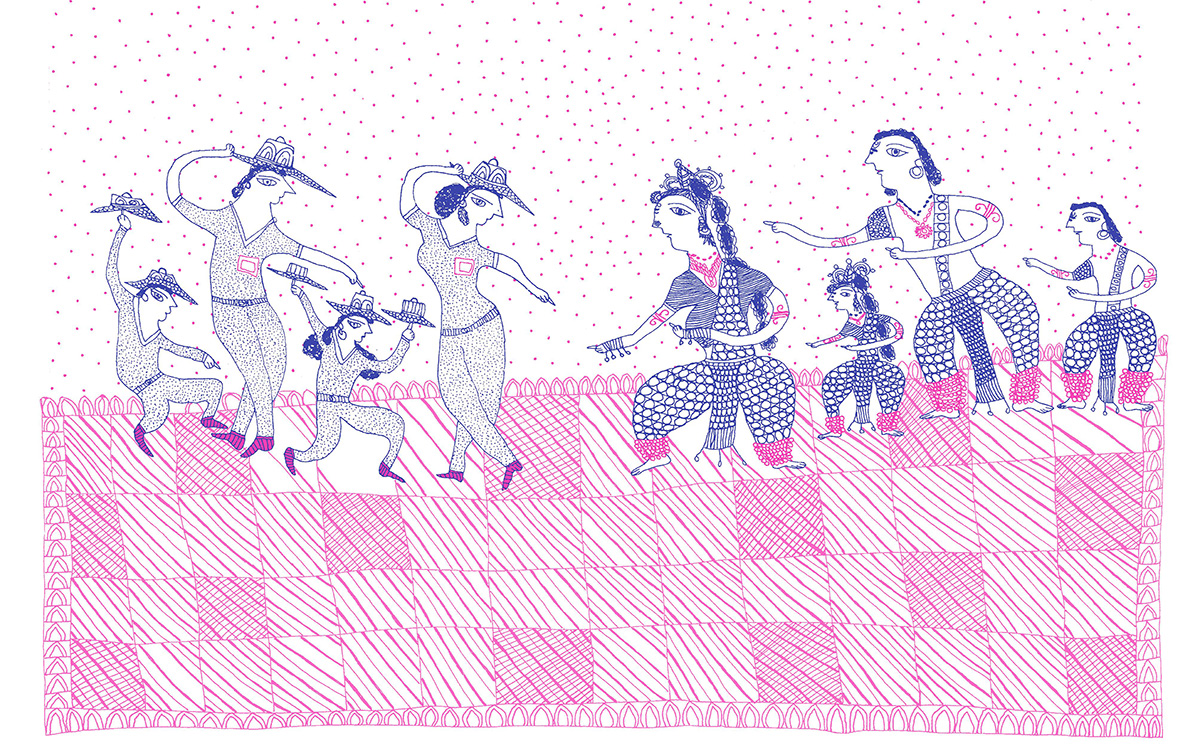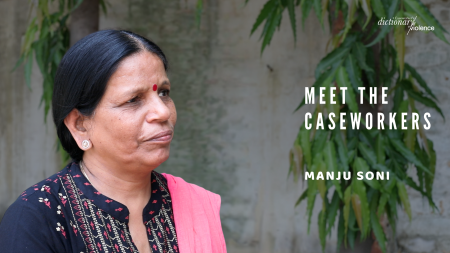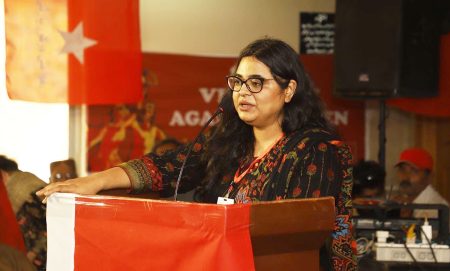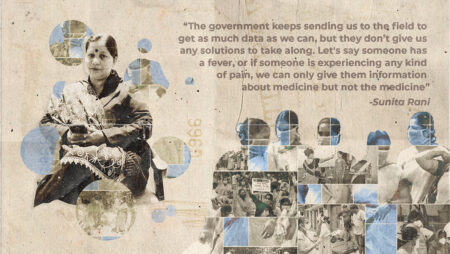Sangita Jogi is a 24-year-old artist, construction labourer and mother of three currently living in Sirohi, Rajasthan. She is the author of The Women I Could Be, a new publication by Tara Books. It is a stunning piece of narrative art.
Sangita is from a nomadic performing community in Rajasthan, although her extended family is settled near Ahmedabad, Gujarat. Most of her family are artists, as are her parents (her mother is the singer and artist Tejubehan). They draw in a style that maybe called ‘urban folk’ in the words of publisher Gita Wolf.
Sangita is deeply interested in what it means to be a modern woman, and draws these meanings with a No.4 Rotring Pen.
1

What do you call your art form, Sangita? Have you given a name to your drawing style?
Papa ke naam se. I’ve learnt painting from my father. He paints beautifully. Bilkul mast. He would take about six months to make one painting. They were very detailed; very fine images taken from life in our village. Especially images around water. He loves water. I love looking at his paintings.
Although, I don’t copy him or want to be like him. Mein sabse alag banna chahti hoon. I want to be unique.
Your mother Tejubehan also has a unique drawing style…
She does, and I think mine is different from hers too. Mein mere mann se banati hoon. I don’t draw what I see, I draw what I imagine. Mein andar se khayal laati hoon. Andar se.
I think about drawing a lot, it’s true. I love it so much that mein sasural me bhi aayi toh mein yeh kaam nahi chod paa rahi (laughs). There is so much housework to do and still…I just can’t leave this.
2

When did you realise you wanted to draw the women you see?
I used to accompany Mummy to her exhibitions in Delhi. And how beautiful are the women who come to these exhibitions at Dilli Haat! These young girls and women, who are clearly coming from college or some other fun place, and…they are just gorgeous.
What did you find beautiful about them?
They just looked so free! Like they have not a care in the world. I mean, for me, all these girls who come to Dilli Haat and Kamla Haat are Miss Indias.
You enjoy watching Miss India?
I’ve never watched. I don’t have a TV at my sasural. But I feel if you are beautiful inside out, you must be Miss India no?
You said you thought they all had come from college…
I mean they all looked like they had studied. The way they spoke…
Did you study?
Till Class II. You think if I had studied I would have got married? (laughs)
3

What did these girls and women you would see in the city, make you feel?
That I wanted to be like them. And in a way, by drawing them, and having the drawings printed in a book these women from the cities may buy, it’s like having what I wished for. These modern-looking women, their clothes! They wear pants. I look at them and I feel they are me. Or I am them.
The clothes you have drawn are exquisite. Which is your favourite painting in the book?
The party scene. I frequently imagine this: people dressing up, going to a party, dancing and making merry. I can imagine it being glorious.
How do you celebrate when you want to?
See, I have never seen a party. Between housework and mazdoori work at the construction site, there aren’t many opportunities to party (laughs).
What kind of work do you do at the construction site?
Kadiya ka kaam which means that I lift the stones and rubble off the site, and I bring the sand into the site. I accompany my husband daily, or whenever there is work. Anyway, I do this, and the housework, and yet I paint. I told you, chodti hi nahin! (Laughs out loud.)
What does your husband think of your paintings?
Oh, I’ve taught him to draw! He really enjoys it. He’s getting pretty good at it.
4

You mention America quite often in the book…
I have always wanted to visit America. I believe the air is very clean there. I’m going to work very hard that I get to go to America one day.
What do you think is the difference in women’s lives between here and America?
Well, to begin with, they don’t have to wear bindis! They wear short clothes! And you know in India, women are working all the time. I don’t know any woman in India that has free time. I believe women in America have a lot of free time. They travel a lot. Kitni mast zindagi hai inki.
5

What do you do for leisure and pleasure?
I get maximum pleasure from feeding my children well.
You enjoy cooking?
I enjoy the fact that I can put good food on the table for them. Kyuki maine itni takleef dekhi hai ke poocho mat. During the lockdown we did not have any food to eat. I used to go to the site and they wouldn’t even pay us. It was immeasurable suffering. During those days, I would dilute rice with water and give them because was there was literally nothing else.
Is this the first lockdown?
Yes. I don’t want to ever relive those days again, and I want to ensure my daughters never see those days again.
How do you want to ensure this?
By making sure they study – here where I am, they don’t believe in educating girls. And even I didn’t study, right?
But you have a book with your name on it.
That’s right. But I’m not leaving my daughters’ lives to chance (laughs). They will study. And hopefully, I will be painting full-time and supporting them.
What do you want to do next?
Abhi mujhe ghar banana hai.
The Women I Could Be by Sangita Jogi, published by Tara Books, is available in all leading bookshops and online at the publisher’s website.





